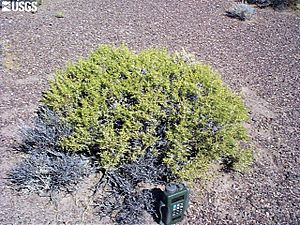Sarcobatus facts for kids
Quick facts for kids Sarcobatus |
|
|---|---|
 |
|
| S. baileyi | |
| Scientific classification |
|
| Kingdom: | Plantae |
| Clade: | Tracheophytes |
| Clade: | Angiosperms |
| Clade: | Eudicots |
| Order: | Caryophyllales |
| Family: | Sarcobataceae Behnke |
| Genus: | Sarcobatus Nees |
| Species | |
|
See text |
|
| Synonyms | |
|
|
Sarcobatus is a group of two types of flowering plants found in North America. These plants used to be thought of as just one type. Some common names for S. vermiculatus are greasewood, seepwood, and saltbush.
For a long time, Sarcobatus was placed in the plant family Chenopodiaceae. However, a newer system for classifying plants, called the APG III system (from 2009), now recognizes Sarcobatus as the only group in its very own family, called Sarcobataceae.
What is Sarcobatus?
Sarcobatus plants are deciduous shrubs. This means they lose their leaves each year. They can grow from about 1.5 to 10 feet (0.5–3 meters) tall. Their branches have spines, and their leaves are a bit succulent (meaning they can store water). The leaves are usually 10–40 mm long and 1–2 mm wide.
One cool thing about these plants is that their leaves are bright green. This is different from most other shrubs in the same areas, which often have grey-green leaves. The flowers on Sarcobatus plants are unisexual. This means that male and female flowers are found on the same plant. They usually appear from June to August. These plants can grow new plants from seeds or from sprouts that come up from their roots.
S. vermiculatus was first discovered in 1806. This happened during the famous Lewis and Clark Expedition. This expedition was exploring the western parts of North America.
Where Sarcobatus Grows
Sarcobatus plants are found across western North America. Their home stretches from southeastern British Columbia and southwest Alberta in Canada. They also grow south through the drier parts of the United States. This includes areas east to North Dakota and west Texas, and west to central Washington and eastern California. You can also find them in northern Mexico, specifically in Coahuila.
Both types of Sarcobatus are halophytes. This means they are special plants that can grow in salty soil. You often find them in sunny, flat areas. They like to grow around the edges of dry lakebeds, called playas. They also grow in dry stream beds and small canyons called arroyos.
If the soil is extremely salty, you might find a different plant called iodine bush instead. Greasewood often grows in large groups, almost by itself. It prefers fine-grained soils where the water level underground is quite high.
Uses of Sarcobatus
Even though some animals can eat greasewood, it can be dangerous for others. If sheep and cattle eat too much, they can get sick. This is called oxalate poisoning. It can cause kidney problems because of certain chemicals in the plant. Sheep are especially sensitive to this.
The wood of the Sarcobatus plant is yellow, very hard, and strong. Because it is so tough, Native Americans used it to make shafts for arrows. It was also used as firewood by both Native Americans and early settlers. The Navajo people traditionally use the wood as stirring sticks, which they call Ádístsíín.
Types of Sarcobatus Species
There are two main types, or species, of Sarcobatus:
- Sarcobatus baileyi was named by Frederick Vernon Coville. This plant is special because it only grows in Nevada. It is a shorter shrub, growing up to about 3 feet (1 meter) tall. Its leaves are usually hairy and are 10–16 mm long. Sometimes, people consider it a variation of S. vermiculatus. However, the Flora of North America still lists them as two separate species.
- Sarcobatus vermiculatus was named by William Jackson Hooker and John Torrey. This species is found throughout the entire area where Sarcobatus grows. These plants are generally 3–6.5 feet (1–2 meters) high. However, some have been recorded growing as tall as 16 feet (5 meters)! Their leaves are usually smooth or only slightly hairy. They are also longer, measuring 15–40 mm.



